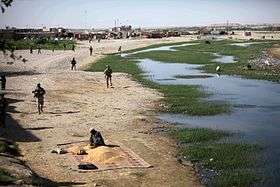Musa Qala District
| Musa Qala موسی قلعه | |
|---|---|
| District | |
|
Valley and mountains surrounding Musa Qaleh | |
 Musa Qala Location within Afghanistan[1] | |
| Coordinates: 32°28′12″N 64°44′24″E / 32.47000°N 64.74000°E | |
| Country |
|
| Province | Helmand Province |
| Occupation |
|
| Population (2012)[2] | |
| • Total | 57,500 |

Musa Qala is a district in the north of Helmand Province, Afghanistan.[3] Its population was around 57,500[2] in 2012 and are 97% ethnic Pashtun. The district centre is the village of Musa Qala; there are 19 other large villages and 200 smaller settlements, mostly along the Musa Qala River. The area is irrigated by the Helmand and Arghandab Valley Authority.[4]
NATO-led International Security Assistance Force extended its presence to this region in mid-2006. Musa Qala, along with the rest of Helmand, was to be under the responsibility of British forces.
The village of Musa Qala was the scene of fierce fighting between British Pathfinder Platoon troops and Taliban insurgents during the summer of 2006. The British had set up a stronghold in the local governor's office and faced daily waves of determined attacks. The British garrison was later relieved by a Danish infantry team who faced renewed insurgent attacks, culminating in better-trained militant fighters equipped with rockets and mortars. After a month of these attacks, the fighting died down, and the Danish forces handed control of the base back to British forces. On 17 October 2006, after a 35-day lull in violence, the British left the village, handing over control to the local elders' council.
On August 26, 2015, Taliban fighters seized control of district headquarters from Afghan forces.[5]
2007 fighting between ISAF and Taliban insurgents
A unit of several hundred Taliban soldiers occupied Musa Qala on February 2, 2007.[6] Eurasianet reports: "The attack laid waste to an agreement there, brokered last fall by Richards and local tribal elders, under which NATO troops agreed to withdraw from the town in return for a commitment by local Afghan leaders to oppose the Taliban."
British General David J. Richards, an expert at negotiation, was the outgoing NATO commander. Eurasianet reports that the new NATO commander, U.S. General Dan McNeill, opposes the kind of local agreements that Richards favored, and speculated that the aerial bombardment that was reported to have killed Mullah Abdul Ghafour in February 2007 was a sign of McNeill's more aggressive, less conciliatory approach.
External links
| Wikimedia Commons has media related to Musa Qala District. |
- Map of Settlements AIMS, May 2002
See also
References
- ↑ "District Names". National Democratic Institute. Retrieved 26 August 2015.
- 1 2 "Settled Population of Helmand Province" (PDF). Central Statistics Organization. Retrieved 15 December 2015.
- ↑ UNHCR District Profile, dated 2002-12-31, accessed 2006-08-01 (PDF).
- ↑ (pdf) The Helmand Valley Project in Afghanistan: A.I.D. Evaluation Special Study No. 18 C Clapp-Wicek & E Baldwin, U.S. Agency for International Development, published December 1983
- ↑ "Taliban capture key Helmand district of Musa Qala". BBC News. Retrieved 26 August 2015.
- ↑ Ahmed Rashid (February 5, 2007). "Taliban takeover of town could mark start of military offensive". Eurasianet. Retrieved 2007-02-05.
.jpg)